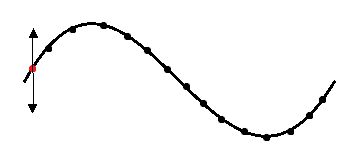
What is the formula for calculating wave velocity?
Answer
484.8k+ views
Hint: Wave velocity is the velocity with which the wave propagates. It is expressed as a product of wavelength of the wave and frequency of the wave in a medium. In vacuum the velocity of all the electromagnetic waves is the speed of light (c).
Complete step by step answer:
Wave is created usually when particles of a medium oscillate about their mean position either along the wave direction or perpendicular to it. Wave are of two types: 1. Longitudinal waves, in which the direction of propagation of the wave is the same as the particle motion. 2. Transverse waves, where the motion of particles is perpendicular to the propagation of the wave. Now, waves travel with some velocity in a medium. When a particle of that medium completes one full oscillation, it does so in time period T. Therefore, the wave velocity is the distance that the particle of the medium covers in this time. ${\text{wave velocity = }}\dfrac{\lambda }{T} = \nu \lambda $ Consider the wave motion in a transverse wave. This wave consists of different particles that are performing simple harmonic motion about some mean position. Consider a particle in this wave (see figure). Consider that this particle is represented by Red Dot in the diagram. When the particle starts from this position and as the wave propagates through this point, it comes back to the same position. That helps in defining the velocity of wave propagation.

Note: Wave velocity is also called phase velocity. This means that we are considering how much time, a particle in a wave is able to come back to the same phase where it started. Phase is the respective angular position that a particle of the wave possesses in terms of mean/extreme position.
Complete step by step answer:
Wave is created usually when particles of a medium oscillate about their mean position either along the wave direction or perpendicular to it. Wave are of two types: 1. Longitudinal waves, in which the direction of propagation of the wave is the same as the particle motion. 2. Transverse waves, where the motion of particles is perpendicular to the propagation of the wave. Now, waves travel with some velocity in a medium. When a particle of that medium completes one full oscillation, it does so in time period T. Therefore, the wave velocity is the distance that the particle of the medium covers in this time. ${\text{wave velocity = }}\dfrac{\lambda }{T} = \nu \lambda $ Consider the wave motion in a transverse wave. This wave consists of different particles that are performing simple harmonic motion about some mean position. Consider a particle in this wave (see figure). Consider that this particle is represented by Red Dot in the diagram. When the particle starts from this position and as the wave propagates through this point, it comes back to the same position. That helps in defining the velocity of wave propagation.

Note: Wave velocity is also called phase velocity. This means that we are considering how much time, a particle in a wave is able to come back to the same phase where it started. Phase is the respective angular position that a particle of the wave possesses in terms of mean/extreme position.
Recently Updated Pages
Class 11 Question and Answer - Your Ultimate Solutions Guide

Master Class 11 Accountancy: Engaging Questions & Answers for Success

Master Class 11 Physics: Engaging Questions & Answers for Success

Master Class 11 Business Studies: Engaging Questions & Answers for Success

Master Class 11 Maths: Engaging Questions & Answers for Success

Master Class 11 Chemistry: Engaging Questions & Answers for Success

Trending doubts
1 ton equals to A 100 kg B 1000 kg C 10 kg D 10000 class 11 physics CBSE

Difference Between Prokaryotic Cells and Eukaryotic Cells

One Metric ton is equal to kg A 10000 B 1000 C 100 class 11 physics CBSE

What is the opposite of entropy class 11 chemistry CBSE

Proton was discovered by A Thomson B Rutherford C Chadwick class 11 chemistry CBSE

1 Quintal is equal to a 110 kg b 10 kg c 100kg d 1000 class 11 physics CBSE




